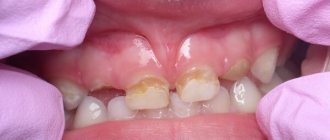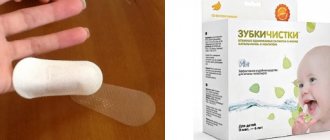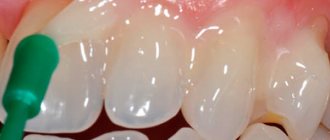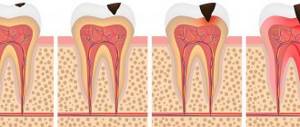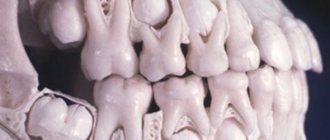- home
- Dental news
- Fluoridation of teeth for children: what is the benefit?
|
|
In the processes of formation of dental tissue, fluorine is necessarily present, which, together with calcium, ensures the density of the structure of the enamel and the entire tooth, and also increases its resistance to the influence of foreign factors. Fluoridation of children's teeth in a dental office can help fill the deficiency of essential fluoride as efficiently and safely as possible for health.
Why is fluoridation necessary for children?
The body in childhood experiences fluoride deficiency. The main factors influencing this are:
- Genetic predisposition.
- General condition of the body. For example, some diseases increase the lack of fluoride, and teeth weaken.
- Poor nutrition.
- Lack of normal child development.
| Due to the factors listed above, tooth enamel weakens and they become sensitive to any changes. The child feels pain when drinking cold or hot drinks or food. Without fluoride, enamel is destroyed and teeth become vulnerable to disease. If caries begins to develop in childhood, there is a high probability that by the age of 30 a person will be missing at least several teeth. Deep fluoridation is an effective preventive measure that increases the resistance of teeth to negative external influences. The risk of disease is reduced many times over. Fluoridation is especially effective when combined with proper hygiene. The child should visit the dentist regularly, use safe brushes and toothpaste recommended by the doctor. |
What to do with a child’s lost baby tooth
Many moms and dads willingly follow the Tooth Fairy tradition. Before going to bed, the baby puts the lost tooth under the pillow, and in the morning he finds a gift in its place. This approach also has practical significance: it helps the child overcome the fear of a lost tooth, because in return he receives pleasant compensation.
If you decide to take action in this direction, tell your son or daughter that the healthier the tooth, the better the gift - this is the attitude of the tooth fairy! Why not unobtrusively motivate the heir to maintain oral hygiene?
If you prefer a traditional approach and are used to following beliefs, you can “give the tooth to the mouse,” bury it in the ground or throw it into the fire. Popular beliefs and signs agree: you shouldn’t keep them, much less make amulets out of them! What if the tooth inadvertently falls into the hands of a witch who performs a magical ritual and harms the child? In the modern interpretation, a witch can be any ill-wisher who can “put the evil eye” on a child.
Indications and contraindications
Deep fluoridation can be carried out from early childhood (from one and a half years). Contraindications
minimum:
|
|
Indications
There is much more to applying the method:
|
|
|
|
|
|
Harm
In addition to the positive aspects, when using this remineralization technique, negative consequences may also arise. The main complication observed after fluoridation of crowns is oversaturation with this microelement.
Due to its excess, fluorosis may occur. As a rule, it is temporary, and after a certain period it reduces the intensity of its manifestation and then disappears completely.
But since the child’s body is susceptible to any changes, before carrying out remineralization, it is worth conducting a detailed examination by a dentist, excluding independent fluoridation of the child’s teeth at home.
How is the procedure done?
Deep fluoridation
It is carried out only in a dental office using special preparations.
The procedure requires minimal preparation. It can be divided into five quick stages
:
- Teeth cleaning. Usually a special paste is used to prepare for fluoridation. But if the child has heavy plaque, another cleaning method is chosen.
- Drying the surface of the teeth.
- “Sealing” the enamel. The doctor applies a drug based on magnesium and calcium (fluorides).
- Second drying of the surface of the teeth.
- Application of the final preparation. Dental clinics use a solution of copper and calcium hydroxide.
| After the procedure, both applied layers react. All components gradually penetrate deep into the tooth, significantly enhancing its mineral structure. An important advantage of deep fluoridation is durability. Components applied to the surface are not washed out and are not affected by food or water. |
Operating principle
This technique is considered a highly effective procedure that has positive dynamics, even with caries at the spot stage. Such results can be achieved due to the peculiarities of action of the drugs used.
To make the enamel more durable using fluoridation, they use products that create a high concentration of fluoride ions over the entire area of the crown .
These products contain submicroscopic crystals of insoluble fluorides, the size of which corresponds to the size of the micropores of dental tissue.
Thanks to this, microelement ions easily penetrate into the deep layers of the tooth, sealing the tubules and binding tissue cells. As a result of the process, the structure of the tooth surface changes, becoming more durable.
Fluorine crystals are slightly soluble, and therefore, having penetrated the enamel and dentin, they can remain there for up to 2 years . During this period, they gradually release trace element ions, constantly supporting remineralization.
To maintain the quality of saturation, it is advisable to carry out this procedure at least 2 times a year.
All drugs used for remineralization have a complex effect and, in addition to saturation with fluoride, have a long-lasting antibacterial effect. Thanks to this, while increasing the strength of the enamel, an outer and inner layer is formed that protects the enamel, as well as the pulp.
Tantum Verde for children: instructions for use.
This article describes how molars grow in children.
The link https://zubovv.ru/detskaya-stomatologia/d-zubi/prorezyivanie-z/sroki-i-nyuansyi-molochnyih.html has a table that indicates the timing of the eruption of baby teeth.
Advantages of fluoridation compared to silver plating
Previously, silver plating was used as a preventative measure. But most leading dental clinics abandoned it in favor of deep fluoridation. Here are the reasons:
|
Dentists speak flatteringly about the deep fluoridation procedure. In an interview with the newspaper “Arguments and Facts”, maxillofacial surgeon David Grigoryan Fr.
You can carry out deep fluoridation at our Nikadent clinic in Mytishchi. The cost of the service is quite affordable - about 2.5 thousand rubles. This price includes: professional consultation, preparation, cleaning of tartar, drying of teeth, application of fluoride.
Methods
Fluoridation of children's teeth can be carried out using various techniques. Currently, there are 5 methods for carrying out this procedure:
- Classical. It involves applying a special gel to the dried surface of the crowns and exposing them to a heat lamp. This technique is one of the least effective, since the applied product is quickly washed off with saliva, rarely reaching the required concentration.
- Deep fluoridation is the most popular and effective technique that can quickly restore enamel and last for a long time.
- Express method . Mainly used for children with poor perseverance. For the procedure, disposable mouth guards filled with a fluoride-containing agent are used, which are placed on the child for 7–10 minutes. The disadvantage of this method is that to obtain a visible effect, it is necessary to carry out about 10 such procedures.
- Burl method. In this case, an individual mouthguard is made for the child, which he can use at home. The use of the cap method is possible only in older children.
- Electrophoresis. Under the influence of electric waves, fluoride ions are released from the drug used, actively saturating the enamel. The technique is quite effective, but has a lot of contraindications.
Of all the listed methods, the most popular is deep fluoridation, which is equally effective for both primary and mixed dentition.
When used, the density of dental tissue increases 10 times.
Prices for pediatric dentistry
| Child therapy | |
| Children's professional oral hygiene | 2,200 rub. |
| Filling teeth with glass ionomer cement (Fuji, Vitremer) | 1,500 rub. |
| Dental treatment using vital amputation in one visit (excluding anesthesia) | 3,600 rub. |
| Seal “Dyract” | 2,200 rub. |
| Pulp amputation with placement of a therapeutic bandage | 1,200 rub. |
| Mechanical and medicinal treatment of carious cavity | 500 rub. |
| Application of devitalizing paste | 500 rub. |
| Deep fluoridation of all teeth | 2,500 rub. |
| Carrying out the resorcinol-formalin method (one session) | 700 rub. |
| Filling root canals with paste (one canal) | 300 rub. |
| Carrying out the method of silvering baby teeth (one tooth) | 200 rub. |
| Application of medicinal paste “Pulpotek” | 1,000 rub. |
| Temporary chemical filling | 300 rub. |
Alternative
As an alternative remedy, silvering of teeth . This method of remineralization allows you to effectively combat the formation of caries and prevent the destruction of crowns.
The silvering procedure is as follows: a thin layer of a preparation containing silver is applied to children's teeth, which forms an invisible protective film.
At its core, silvering of baby teeth is a method of caries preservation , allowing it to be stopped at a certain stage. Often, this method allows you to wait until the period when the child can independently make a positive decision about dental treatment.
Despite the fact that silvering takes place in a matter of minutes and does not cause discomfort or negative attitude on the part of the child, the procedure is not successful, as it has low aesthetic properties.
Silver, under the influence of oxygen and saliva, begins to oxidize and darken, making the teeth almost black.
How does Kalgel gum gel work during teething and how long should it take to expect an effect.
Is it possible to walk with a child if he has a teething fever? Here is the opinion of experts.
How to treat stomatitis in children? A 1 year old child has ulcers in his mouth. Here https://zubovv.ru/detskaya-stomatologia/polost-rta/stomatit/chem-nado-lechit.html recommendations are given on what to do.
What is the procedure
Fluoridation in children is carried out to protect children from caries, since they have a very fragile bone structure. For this reason, caries in children progresses very quickly, destroying the incisors. The procedure is aimed at strengthening the enamel by applying microscopic crystals with fluoride particles to it.
It reliably seals the dentinal canals, increasing the thickness and strength of the enamel. This treatment allows baby teeth to be more resistant to various mechanical damage, pathogenic microorganisms and food acids. The procedure allows you to quickly restore the mineral composition of the enamel.
Quite often, parents neglect the condition of baby teeth and the child. And this subsequently leads to problems and diseases at an older age. Therefore, at the slightest sign of caries or if the integrity of the enamel is damaged, it is necessary to visit the dentist. Only a doctor decides whether children need fluoridation.
There are 2 types of procedure:
- Simple fluoridation, in which strengthening enamel, gel or varnish is applied to the surface. These components cannot protect the MH from caries, so this procedure is in most cases carried out for preventive purposes.
- Deep fluoridation of teeth in children is carried out using special enamel, after application of which the liquid firmly seals microcracks, penetrating into the very depths of hard tissue. It contains a large amount of fluoride ions, which not only strengthen the enamel, but also protect teeth even from deep lesions. The enamel becomes dense, due to which children do not experience subsequent destruction of baby teeth. After this procedure, children are not diagnosed with caries, and temporary teeth remain healthy until permanent teeth appear.
Stages
- Cleaning the surface of teeth from soft plaque and tartar;
- Drying – the surface of the teeth must be dried as much as possible for high-quality fluoride varnish coating;
- Applying a composition with fluorides, magnesium and copper salts using a special brush or a sterile cotton ball;
- Repeated drying for 5-7 minutes naturally;
- Treatment with a composition containing calcium hydroxide.
The formed durable film on tooth enamel, consisting of fluoride ions, is resistant to drinks, food, hygiene procedures, does not fade or deteriorate over time.
Diagnosis of fluoride deficiency
The fluoridation procedure is based on the saturation of tooth enamel with fluoride preparations. A sufficient amount of fluoride is very important for the health of tooth enamel and the entire tooth. The lack of substances such as fluorine is, in principle, not visible to the naked eye. And the problem can only be diagnosed at an appointment with a dentist. However, if your teeth become more or less susceptible to caries, various microcracks and noticeable areas of darkening appear on the enamel, then consult a doctor immediately; most likely you have a fluoride deficiency. Timely, qualified assistance from a dental specialist can stop any destruction of tooth enamel. Well, and, of course, if your doctor recommends a fluoridation procedure for you, then go through with it. It will saturate all the necessary areas of the tooth with fluoride, and as a result strengthen the enamel. Not many people know, but this procedure also kills harmful bacteria on the surface of the tooth, which means that after it you will forget about the problems of caries for a long time.

